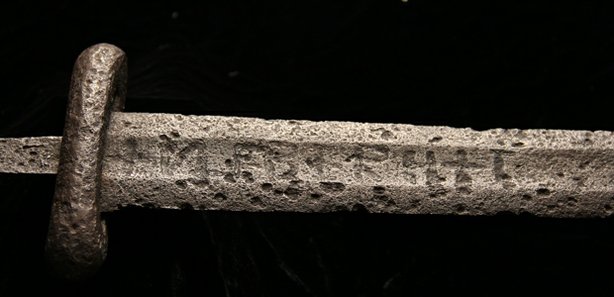by Robert Krulwich
So tell me: Of all the males on our planet—and I’m talking
all,
scale be damned, from the littlest insects to the biggest of
whales—who’s got the most impressive appendage? Who (you should pardon
the expression) is our Biggest Daddy?And I don’t mean just sex organs, impressive as they sometimes are.
I’m talking about any outstanding male appendage—whatever guys have that
thrills the ladies, the obvious non-penile example being the peacock
tail, which as we all know when fully displayed makes peahens dream of
George Clooney.
Impressive? Yes. The problem being that between trysts, a superheavy
tail must be a drag to lug around. It costs energy to maintain and more
energy to get up and unfurled. But the drive to reproduce is a powerful
thing, and sexual selection, as Darwin taught us, just keeps pushing the
limits of bigness.
Obviously, there is such a thing as
too big. I imagine it gets awkward to be a walrus with tusks curling dangerously close to your chest.
And the weight of these things? Not the absolute weight, but the
proportional weight—that’s another limitation. How much can a guy carry?
According to Douglas Emlen in his wonderful book
Animal Weapons: The Evolution of Battle,
while the rack of bone that sits atop a male caribou is hugely
impressive (those antlers can weigh 20 pounds and stretch five feet
across) …
… as big as they are, they account for only 8 percent of the male’s
total body weight. Moose and elk have even larger antlers, but even the
biggest elk antlers equal only 12 percent of its body weight. So that’s
doable. Once upon a time, 11,000 years ago, there was a deer (called
Megaloceros giganteus, or the Irish elk) that wandered Europe and Asia,
and those guys had boney tops so insanely branched, so crazily big, that
our prehistoric humans painted them worshipfully onto the cave walls at
Lascaux.
But even these antlers, 12 feet across and wildly branched, weighed less than 20 percent of the total animal.
Go Small to Get Big
You have to drop down to the insect family, to a group of horned
beetles, to find a big appendage that approaches a third of the animal’s
body weight. There are several beetles that have fighting, clamping
horns almost the size of their bodies, and a thing like that growing out
of your skull, writes Emlen, “is a little like having your leg sticking
up out of your forehead.” You feel it.
But if you’re looking for the male who wears the crown, whose
appendage is so big, so startling, so colorful, so attractive, so
monstrous, and therefore unequaled in the animal kingdom—if you’re
looking for the champ? Well …
He’s not in the African savannah. He doesn’t have a tusk. He’s not
especially large. You have to look down to see him, down near your feet
when you’re at the beach. This is him:
He’s a fiddler crab. And that appendage is his claw. And while sizes
vary from crab to crab, the biggest fiddler crab claws weigh roughly
half the body weight of the animal. Half! That’s nature’s biggest
appendage, says Emlen. And what is it for? Not for feeding. The claw is
useless at mealtime. Males eat with their other, smaller claw only. But,
says Cornell biologist John Christy,
the claw’s bright colors definitely attract female attention. It can
also snap down and inflict real harm, so they’re potential weapons. But
mostly, he discovered, males use them—I kid you not—to wave.
“Up and down, up and down, again and again,” writes Emlen, “they
raise their claws high and drop them. Dozens of times each minute,
thousands of times per hour, hour after hour … ” They look a little
silly doing this, like a lonely fan trying to start a stadium wave.
Check out this fellow:
Why are they waving? It’s a warning. “Look what I’ve got!” the male
is saying to any male who would trespass into his burrow. “This thing is
going to pound you if you come near, so
stay away!” In effect,
Emlen writes, “fiddlers are employing their claws as warnings rather
than instruments of battle.” And it works. “An overwhelming majority of
contests end before they ever begin, without anything even resembling a
fight. A mere glance at a big claw is sufficient to deter smaller
males.”
The male has built a tunnel, which leads to a nesting burrow. His
claw has attracted a lady, and she’s down below raising his family. His
job is to stay on top, waving till she’s done or he drops. It’s a tough
life, lifting that gigantic appendage over and over, using up energy, constantly getting bothered
by would-be challengers. The male can’t eat. Not while he’s guarding.
His food is at the water’s edge, which is down lower on the beach. So he
stands there, day after day, getting hungrier, until eventually, Emlen
says, “Even the best males run out of steam and are forced to abandon
their burrows to go feed and refuel. The instant they leave, others will
claim their burrows.” And then they become challengers and have to
start all over again.
So while it may be glamorous to top the list of Biggest Appendage
Ever, what with the lifting, the waving, the straining, the not eating,
the worrying about how long you’ll last, it might be better to have a
medium-size claw and not have to be always worrying about the biggest
bullies at the beach. Yes, the big claw does dramatically increase your
chances of producing babies, which, as Darwin will tell you, is the
whole point. But if I were a fiddler crab lucky enough to have the
biggest appendage in the world, I think I’d get myself a nail file (claw
file?), erase my genetic advantage, and spend lazy afternoons sipping
pond scum by the ocean’s edge. I like a gentler life.































